There is much to celebrate about asset owner signatories’ responsible investment practices.
Over 90% have a public responsible investment policy. Analysing prospective/existing managers’ responsible investment credentials, and their alignment with the asset owner’s responsible investment strategy, is common. More than 85% of asset owner boards now have some oversight of climate-related challenges, and three-quarters have started to take steps to implement the Task Force on Climate-Related Financial Disclosures (TCFD) recommendations. Aligned with the findings of the Legal framework for impact project, fiduciary duty is often cited as a primary driver for pursuing a responsible investment approach.
Key areas for development
This report also identifies a range of areas where signatories could go further. Some of the key ways that asset owners could develop their responsible investment practices, are:
- Formalise responsible investment requirements in contracts. The number of asset owners embedding responsible investment considerations into contractual arrangements is substantially lower than the number considering them during selection. Nearly one in three do not include a requirement to follow the asset owner’s responsible investment strategy for a majority of AUM.
- Robustly implement TCFD recommendations. Less than 10% of asset owners are implementing the TCFD’s recommendations across all four of its pillars: governance, strategy, risk management and metrics and targets. One in five asset owners have not identified any specific climate-related risks, one in seven do not have board-level oversight of climate-related risks and opportunities and more than 40% are not conducting scenario analysis.
- Increase attention paid to social issues including human rights. When asked about their responsible investment priorities for the next two years, the majority of asset owners focus on plans relating to climate change. Human rights, modern slavery and a “just” transition to a low-carbon economy are mentioned, but infrequently.
- Expand responsible investment approach across asset classes and strategies. Responsible investment practices are less common in certain asset classes, such as hedge funds, and in particular strategies/approaches, such as passive investing. Senior leadership statements from many asset owners talk about plans to expand the sophistication and breadth of responsible investment practice.
- Assess specific stewardship practices. While the majority of asset owners assess how prospective and existing managers implement a stewardship policy, oversight of specific stewardship actions – such as how the escalation process is deployed, and the levels of involvement in collaborative initiatives – is less common.
The PRI will continue to grow its suite of resources for asset owners to support their development in these and other areas. See Next steps for the PRI for more details.
PRI reporting is the largest global reporting project on responsible investment. PRI signatories are required to report on their responsible investment activities annually (following a grace period in their first year of joining).
Asset owners head the investment chain, setting the direction of markets. This report analyses responses from 454 asset owner signatories that participated in PRI reporting in 2021.[1] It highlights which practices are highly developed, and which remain nascent.
The data analysed comes from four modules of the PRI Reporting Framework: Senior leadership statement (SLS 1); Selection, appointment and monitoring (SAM 3, 4, 6, 7, 11, 13, 14, 17, 22); Organisational overview (OO 1) and Investment and stewardship policy (ISP 2, 13, 28-40).
This report is the latest in a series of analyses of PRI reporting data.
Any feedback or questions on this report can be sent to [email protected].
Methodology
The PRI commissioned Aon to support with the data analysis. Members of Aon’s Responsible Investment team and its Centre for Innovation and Analytics in Singapore structured and analysed the data to identify salient themes.
Univariate analysis was conducted to understand the general frequency distribution of the responses from asset owners within the Investment and stewardship policy (ISP) and Selection, appointment and monitoring (SAM) modules. Pairwise analysis was then used to identify any trends in the frequency distribution against the asset owners’ AUM band, region, and organisation type. Indicators that had a chi square p value of .0.05 were then subjected to a further qualitative review.
Natural language processing (NLP) techniques were applied to the free text responses across the Senior leadership statement (SLS) module, first cleaning up the responses (standardising cases; removing special characters, punctuation and hyperlinks; filtering out commonly used words that do not add value and lemmatisation), before visualising the results in frequency bar charts and word clouds (see figures 5, 6 and 7).
This report explores:
- PRI asset owner signatories: where and what
- Statements from the top
- Responsible investment policies
- Selecting, appointing and monitoring managers
- Action on climate
- Next steps for the PRI
PRI asset owner signatories: where and what
Asset owner signatories to the PRI come in all shapes and sizes, representing a diversity that is important to remember when assessing the range of practices seen. Region, size and type of organisation are all important differentiators.
The number of asset owner signatories also continues to grow – at around 15% each year – sitting at nearly 700 in early 2022.
Figure 1: PRI asset owner signatory growth
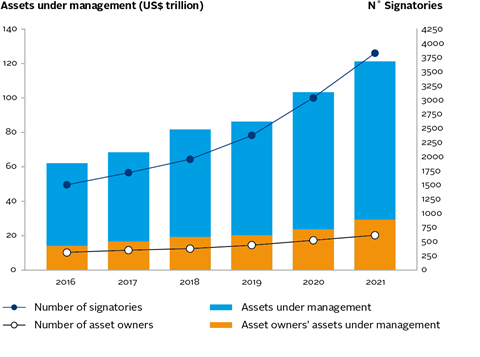
Retirement plans make up more than half of the total (35% non-corporate plus 18% corporate), with insurance funds the next largest group at 17%.
Figure 2: Asset owners by AUM
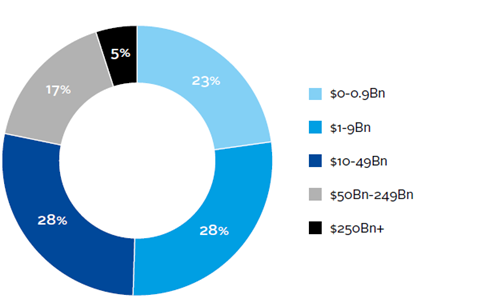
Nearly 80% of asset owners surveyed manage less than US$50bn and more than half manage less than US$10bn.
Figure 3: Asset owners by region
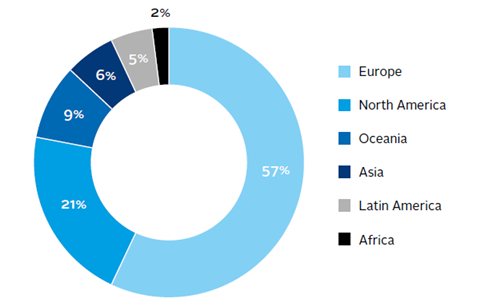
Geographically, traditionally large markets for responsible investment continue to dominate. Nearly 60% of the asset owners are headquartered in Europe, with another 21% based in North America. Four countries – UK, US, Canada, Netherlands – account for 41% of asset owner signatories on their own, with the next five – Australia, France, Germany, Japan, Sweden – making up another 28%. Brazil (3%) and South Africa (2%) are the largest emerging market sources of PRI signatories.
Despite the size of the economy, fewer than 1% of the asset owners are based in China.
Figure 4: Asset owners by type
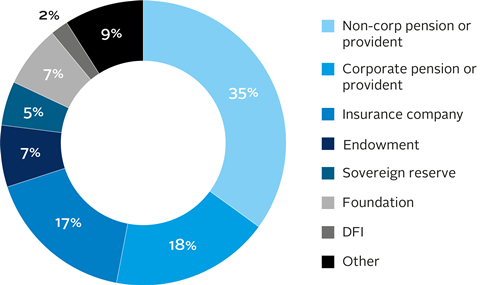
Statements from the top
- The most cited motivations for pursuing responsible investment are long-term value/returns, risk management, opportunities and fiduciary duty.
- Climate change is the most common area asset owners say they have made recent progress on, although few are thinking about a gjust h transition.
- In looking ahead, asset owners talk about increasing the breadth and sophistication of their ESG integration, measuring and reducing greenhouse gas emissions and mitigating climate-related risks.
The senior leadership statement – signed by the chief executive officer, the chief investment officer or a similarly senior member of the organisation’s leadership – asks signatories to provide a high-level view on the organisation’s approach to, and achievements on, responsible investment.
Having senior-level oversight of responsible practices is one of the minimum requirements of being a PRI signatory.
The senior leadership statement serves to:
- spread awareness and accountability for PRI reporting, and responsible investment in general, throughout the organisation;
- encourage internal use of PRI reporting for decision making and for tracking progress;
- frame signatories’ detailed reporting within their general responsible investment beliefs.
Motivations
In describing why the organisation engages in responsible investment, many signatories talked about financial returns, with references to long-term value/returns, risk management, opportunities and fiduciary duty all common. This aligns with the findings of the Fiduciary duty in the 21st century and Legal framework for impact projects, which explore the link between responsible investment and investors’ financial goals. In terms of issues, climate change is by far the most cited, followed by human rights. Being an active owner was also referred to frequently.
“Investors that fail to incorporate ESG issues are failing their fiduciary duties and are increasingly likely to be subject to legal challenge.”
Fiduciary duty in the 21st century
“Where sustainability impact approaches can be effective in achieving an investor’s goals, the investor will likely be required to consider using them and act accordingly.”
A legal framework for impact
Figure 5: Reasons for engaging in responsible investment
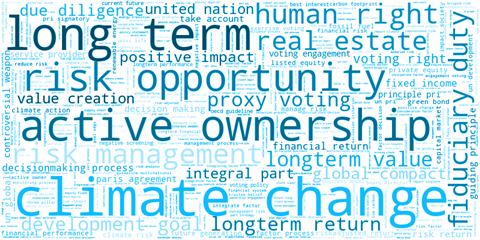
Recent progress
When asked about progress on the issues most relevant or material to the organisation, climate change was the dominant theme. Human rights, modern slavery and biodiversity are mentioned, but infrequently. Diversity, equity and inclusion is rarely mentioned, particularly outside of North America.
Many asset owners refer to their work with, and support for, major collaborative initiatives and frameworks, with The Paris Agreement, Climate Action 100+, the Net Zero Asset Owner Alliance, Task Force on Climate-Related Financial Disclosures (TCFD) and the UN Guiding Principles on Business and Human Rights all being referenced often.
While asset owners talk about the need to transition to a low-carbon economy, mentions of a “just” transition do not often feature.
Figure 6: Progress on most relevant issues

Future plans
In looking ahead, asset owners talk about increasing the breadth and sophistication of their ESG integration across all asset classes, measuring and reducing greenhouse gas emissions – including setting net zero targets – and developing a roadmap for mitigating climate-related risks. To support this, asset owners are asking for more emissions metrics from managers, such as carbon footprints and weighted average carbon intensity.
Outcomes-based investing is also discussed, with mentions of increasing investment in positive outcomes, the SDGs and impact investing all featuring.
Many call out interest in collaborating with like-minded investors and organisations to better understand best practice and achieve these goals.
-
Net Zero
launch our target, which includes what we need to look for from AMs and which asset classes we need greener options for.
-
COP26
linking up with government plans and using our role as co-chair of an IIGCC working group to raise the importance of managing physical risks from climate change.
-
Biodiversity
committed to looking at this more and what this means for our investments.
-
Engagement with our members
providing clearer information on all our activities. Continue work with our BAME members and supporting the Diversity Project.”
UK retirement plan, US$1bn–US$9bn AUM
Figure 7: Plans for the next two years

“Instead of putting optimised short-term returns first and foremost, most investors are prepared to understand that investing for the longer term does not align with beating benchmarks on a quarterly basis.”
Mette Charles (ESG Research Lead, Global Investment Practice, Aon)
Policies
- More than 90% of asset owner signatories make their overall approach to responsible investment publicly available.
- One in three publicly outline their approach to sustainability outcomes.
- The amount of public information is typically higher amongst larger asset owners, those based in Oceania/Europe/Asia and amongst DFIs and sovereign reserves.
An investment policy guides an organisation on investment decisions, asset allocation, ESG incorporation, how asset managers are selected and appointed, how stewardship is carried out and how an organisation reports on its activities.
It is a minimum requirement of being a signatory to have the organisation’s overall approach to ESG factors laid out – either within the main investment policy or in a dedicated responsible investment policy. Many also choose to make these policies public, which increases transparency.
Explore the PRI’s resources on writing a strategy and policy
Public statements
More than 90% of asset owner signatories make their overall approach to responsible investment publicly available. Around two-thirds make the organisation’s approaches to stewardship and exclusions public, whereas only one in three publish asset class-specific guidelines for ESG incorporation or approaches to internal reporting and verification.
About one in three publicly outline their approach to sustainability outcomes.
There is a clear trend for larger asset owners to have more publicly available policy elements (although there are many examples of smaller asset owners that have published detailed and wide-ranging policies that incorporate many of the elements asked about).
Differences are also evident between regions, with asset owners in Oceania, Europe and Asia more likely to have more substantial policy information public. Across asset owner types, development finance institutions (DFIs) and sovereign reserves typically publish more policy information than retirement plans, with endowments and foundations typically publishing the least.
Figure 8: Publicly available policy elements

Figure 9: Policy elements publicly available, by AUM, region and type
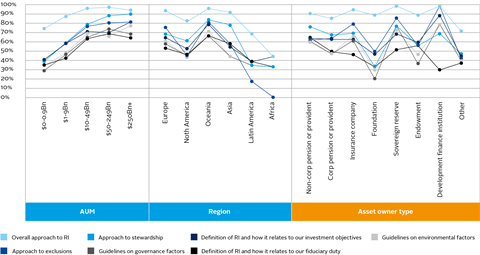
Stewardship
Similar trends are seen within organisations’ stewardship policies (which can be standalone or part of a wider policy), with fewer small asset owners, endowments and foundations having wide-ranging stewardship policies. Where smaller asset owners have a policy, it is less likely to require them to take specific actions, which is also true of endowments. Again DFIs and larger asset owners are more likely to have policies covering a broader range of approaches and issues.
Figure 10: How stewardship policies are primarily applied
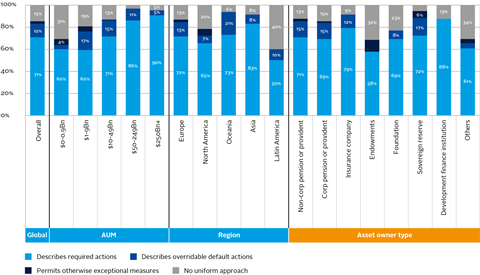
“We have seen some asset owners that initially had their responsible investment policy set to divestment from certain sectors or negative screening, recently change to active engagement and impact investing. They are increasingly recognising the power of active ownership and engagement, and asking themselves – are we part of the problem or solution?”
Geri McMahon (Partner, Co-head of Responsible Investment, Aon)
Selecting, appointing and monitoring managers
- Considering prospective managers’ responsible investment credentials is common, but requiring that managers undertake specific practices as a condition for selection is much more variable.
- Nearly one in three do not contractually require managers to follow the asset owner’s responsible investment strategy for all or a majority of AUM.
- Monitoring a manager’s alignment with the asset owner’s responsible investment strategy is common, but many do not monitor how ESG incorporation affects financial and ESG performance.
Responsible investment should be at the heart of the relationship between an asset owner and their investment manager. It is therefore crucial that asset owners assess potential managers’ responsible investment credentials when selecting one, formalise their responsible investment requirements into contracts and evaluate chosen managers’ responsible investment performance over time.
Explore the PRI’s resources on selecting, appointing and monitoring managers
Selection
When selecting managers, the most common things for asset owners to assess against responsible investment criteria are the manager’s overall approach and its policy, while factors such as the organisational culture and oversight/governance are looked at the least, but still typically considered.
Figure 11: Aspects assessed against responsible investment criteria (for all/majority/minority/none of AUM)

While considering these aspects when selecting managers is common, requiring more specific practices is much more variable. The most common requirement is that managers incorporate material ESG factors in all investment analyses and decisions, required for instance by 72% of asset owners for their actively managed listed equity assets. However, when it comes to passively managed listed equity assets, this is true for only 55% of asset owners.
This is a trend that continues across requirements and asset classes, with e.g. 61% of asset owners requiring that all their actively managed fixed income assets comply with their exclusions policy, but only 51% requiring the same for their passively managed fixed income investments.
In addition to this focus on material issues, in major asset classes around 40% of asset owners are requiring external managers to track the positive and negative sustainability outcomes of their activities.
Figure 12: Responsible investment practices required when selecting managers (for all/majority/minority/none of AUM)
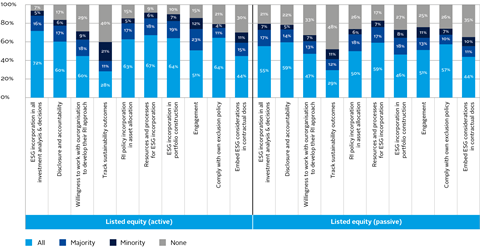
Stewardship
When assessing a manager’s stewardship practices, the most common things asset owners look at is whether they allocate sufficient resources (79% do so for all or a majority of externally managed assets), whether the investment team is involved (79%) and how the stewardship policy is implemented (77%). The least common activity or action reported by asset owners being how the escalation process is deployed (60%) and whether the manager takes an active role in collaborative initiatives (57%) (although tracking participation in collaborative initiatives is more common (70%)).
In assessing managers, asset owners are far more likely to rely on the managers’ standard client reporting, than to look at more in-depth information and primary data sources such as: voting and engagement history; policy engagement history; controversies and incidence reports.
Figure 13: Documents reviewed when assessing managers (for all/majority/minority/none of AUM)

Appointment
The number of asset owners embedding responsible investment considerations into contracts is noticeably lower than the number considering it during selection. Even a fairly broad requirement to follow the asset owner’s responsible investment strategy for all or a majority of AUM is not being included in contracts by nearly one in three.
External initiatives and frameworks are often not referenced. Where they are, commitments to respect human rights in line with the OECD Guidelines for Multinational Enterprises and the UN Guiding Principles on Business and Human Rights are the most common – mentioned for all or a majority of AUM by 40% of asset owners. Including commitments to disclose against frameworks such as TCFD and the EU taxonomy for sustainable activities are unusual.
Figure 14: Clauses included in contractual agreements (for all/majority/minority/none of AUM)

Monitoring
Monitoring tends to be high-level – monitoring a manager’s alignment with the asset owner’s responsible investment strategy is much more common than monitoring how ESG incorporation affected financial and ESG performance. Across major asset classes, fewer than 60% of asset owners are doing this for all or a majority of assets, despite the proliferation of references to performance in senior leadership statements (see Statements from the top).
Monitoring responses to material ESG incidents is notably higher in infrastructure (82% for all or a majority of assets) and real estate (78%) than in other asset classes.
Figure 15: Aspects of external managers’ practices monitored (for all/majority/minority/none of AUM)
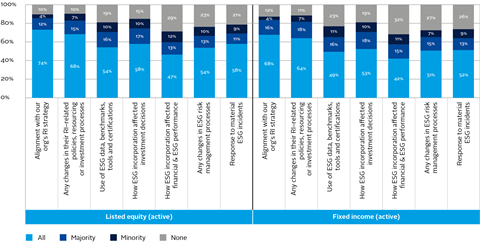
Stewardship
Monitoring of stewardship practices also tends to focus on high-level activities and actions. Staying on top of policies and processes is the only action that a majority of asset owners do across all their assets (60%-65% across major asset classes). Again, this is notably more common in real estate and infrastructure (both 73%).
The least common stewardship activities monitored are the degree to which managers take an active role in collaborative stewardship initiatives (ranging from 23% to 64% for all assets, across classes), and how the escalation process is deployed in instances where initial stewardship efforts are unsuccessful (29%-43%).
Escalation
Most asset owners (around 80% overall across asset classes) have an escalation process of some kind to address concerns raised by monitoring. The most common approaches include telling the manager that they have been placed on a watchlist and terminating the contract if failings persist.
Engaging with the manager’s board or investment committee is more common in private equity (45%), infrastructure (43%) and real estate (40%) than in other asset classes.
“Asset owners may want their manager to demonstrate expertise in specific areas where they have common alignment, or want the manager to demonstrate how it has used capital to advocate for change in the past. Asset owners also increasingly seek greater transparency from their managers, e.g. how they are acting in practice, how forthcoming they are with information.”
Jennifer O’Neill, CFA (Associate Partner: ESG and Responsible Investment, Aon)
Climate
- More than 85% of asset owner boards oversee climate-related challenges in some capacity; 30% engage with beneficiaries to understand their preferences on climate.
- More than 40% of asset owners do not use scenario analysis to assess climate-related risks and opportunities.
- Three-quarters of asset owners have taken steps of some kind to implement TCFD recommendations, although fewer than one in ten are doing so across governance, strategy/ scenario planning/risk management and target setting.
Climate change is an urgent, existential challenge facing societies, making adaptation and mitigation a priority ESG issue for asset owners. PRI reporting anchors its climate questions around the eleven TCFD recommendations, covering: governance; strategy; risk management; metrics and targets.
Governance
Board oversight
The vast majority of asset owner boards oversee climaterelated challenges in some capacity, but one in seven do not. Trends across asset owners of different sizes, regions and types are clear: the boards of the smallest asset owners are seven times less likely to exercise any oversight over climate risks than those of large asset owners (28% vs 4%); Latin America is the starkest geographical outlier, with two-thirds of boards not exercising any oversight on climate.
On average, 30% of asset owners engage with beneficiaries to understand their preferences on climate, reaching as high as 50% in Oceania.
Figure 16: How the board exercises oversight of climate-related risks and opportunities
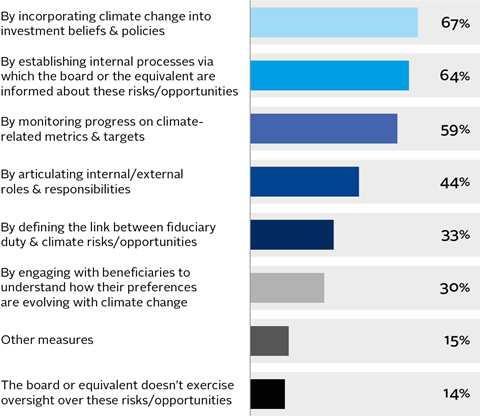
Figure 17: How the board exercises oversight of climate-related risks and opportunities, by AUM, region and type
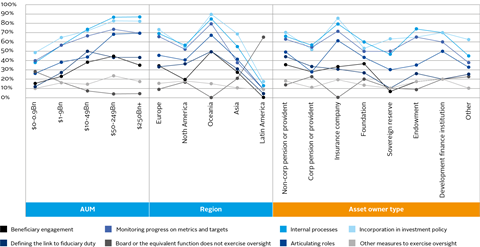
Senior management’s role
Senior management are significantly more likely to be involved in assessing and managing climate-related risks and opportunities in larger asset owners than smaller ones. Regionally, again it is far more common in Oceania, and by far the least common in Latin America. Insurance companies and DFIs stand out as being more likely to have senior management involved than other types of asset owners.
Figure 18: Senior management involvement in assessing and managing climate-related risks and opportunities

Figure 19: Senior management involvement in assessing and managing climate-related risks and opportunities, by AUM, region and type
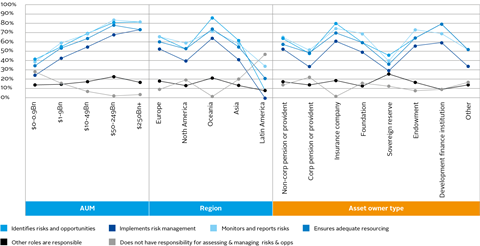
Strategy
Identifying risks and opportunities
One in five asset owners have identified no specific climaterelated risks, rising to more than half in Latin America (57%) and Africa (56%). Smaller asset owners are nine times more likely to say that they have not identified specific risks than larger ones (36% vs 4%).
Scenario analysis
More than 40% of asset owners do not use scenario analysis to assess climate-related risks and opportunities, with particularly few doing so amongst smaller asset owners (more than 60% not doing it), those in Latin America (96%) and endowments (67%).
There is a sharp drop-off in the severity of scenario that asset owners are likely to consider. While 46% use “an orderly transition to 2o C or lower” as a scenario, only 30% are considering “a failure to transition, based on 4o C or higher”.
“Long-term assumptions about return and risk for the various assets, as well as how these returns relate to the development of the social economy and demography, are central to the analysis. Analysis is based on the expected negative impact on economic growth in a scenario where sufficient global measures are not taken, and the global temperature increase is 3o C instead of being limited to around 1.5o C.”
European sovereign/government-controlled reserve, US$10bn-US$49bn AUM
“A Bank of England stress test has been carried out on the fund’s segregated equity and corporate bond holdings under this scenario. […] we are looking for tools/methods that allow us to include the private market assets into scenario testing, in order to get a full picture. In addition, we increasingly require our managers to conduct climate resilience testing on the mandates they manage and report on the findings on an annual basis as part of TCFD.”
UK corporate retirement plan, US$10bn-US$49bn AUM
Risk management
Eighty of the asset owners responded to the voluntary question on which risk management processes are in place to identify and assess climate-related risks. Of this subset, more than one in three use TCFD (putting requirements on companies (41%) and/or on external managers (34%)). Two-thirds use “other risk management processes”, with free text responses showing many cases of this meaning proprietary approaches being favoured over following a major framework. Use of benchmarks and third-party data are common.
“We annually conduct climate risk analysis of our entire portfolio. The risk analysis differs per asset class due to data availability. For listed equity we measure CO2 emissions and conduct stress testing based on the methodology of the Dutch Central Bank. The results are shared with the ESG committee where [our] risk department is represented.”
Dutch non-corporate retirement plan, US$10bn-US$49bn AUM
“Climate related risks are examined on an overall portfolio level. We measure the carbon footprint, ESG rating, and other climate risks through PACTA, IPR and proprietary WTW tools.”
Spanish corporate retirement plan, US$1bn-US$9bn AUM
Metrics and targets
Just over half (53%) of asset owners set organisation-wide targets on climate change, with the most common being targets related to investing in low-carbon, energy-efficient climate adaptation opportunities.
While 75% of asset owners have taken steps of some kind to implement TCFD recommendations, fewer than one in ten are doing so across governance, strategy/scenario planning/ risk management and target setting.
Figure 20: Asset owner disclosures on climate risk
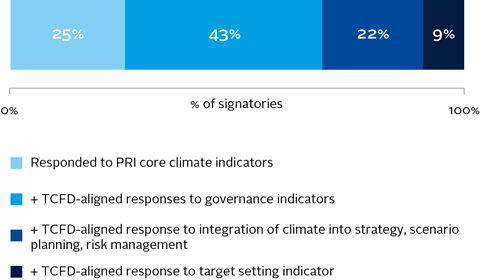
“Identifying and acting on climate-related risks is not straightforward. Decisionmakers – be they asset owners or their fund managers – cannot switch this on or off overnight. It requires a wider education and governance undertaking. There is also an opportunity for asset owners to learn from those who are further ahead in their journey.”
Tim Manuel (Partner, Co-head of Responsible Investment, Aon)
Next steps for the PRI
To support asset owner signatories, particularly in some of the areas this report has shown to be most in need of development, the PRI will add to its existing suite of resources for asset owners by providing:
- guidance and case studies on incorporating responsible investment into investment mandates;
- additional support on implementing the TCFD recommendations;
- case studies on how to consider human rights;
- opportunities to join collaborative engagements on social issues;
- dedicated resources for smaller asset owners;
- resources on how to align passive investments with responsible investment principles.
See the PRI’s 2022/23 work programme for more details.
Downloads
Inside PRI data: asset owner action
PDF, Size 17.89 mbInside PRI Data: Asset Owner Action Report Summary Slides
PowerPoint, Size 6.62 mbInside PRI Data: Asset Owner Action Report Summary Slides – Japanese
PDF, Size 1.01 mb
References
[1] Data for 14 out of the 468 asset owner signatories that completed PRI reporting in 2021 have been excluded from this dataset due to technical issues. The data from the 454 signatories included (97%) is unaffected.












